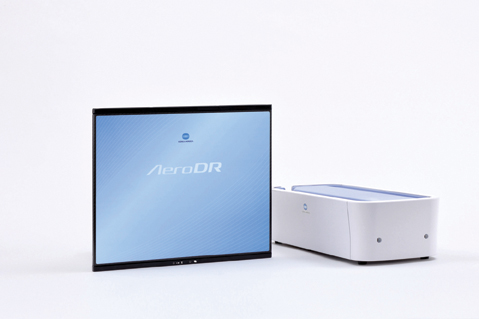
AeroDR, photo courtesy of Konica Minolta.
Few imaging market segments have seen as much activity in the past six to nine months as digital radiography (DR) has. Comprising everything from retrofit kits to full suites — with a score of wireless options — the marketplace is filled with vendors improving old systems, introducing new ones and getting their products into more healthcare providers’ hands.
This flurry of activity was underway when KLAS wrote its annual report, “Digital X-Ray 2011: An Untethered Market,” last year and has continued since then. KLAS interviewed healthcare providers regarding their experiences with different vendors’ products and identified current trends. The report noted the number of changes that had occurred and that “…wireless digital X-ray has seen high adoption.” It also observed that providers were feeling the pressure to stretch their radiology dollars as far as possible, and wireless DR was helping in that regard.
“The cost to retrofit with wireless is relatively low,” the report said, and wireless systems are easy to implement.
“Wireless technology has also helped meet providers’ needs for patient throughput and workflow, while maintaining a high return on investment,” the report summary said.
The improved quality of DR in general also has been notable. “Most providers feel that the technology allows them to do everything they need to do,” said KLAS.
Improvements have made the systems more ergonomic, easier to use, with quicker processing and, perhaps most important, improved image quality. Image quality has gotten so good, in fact, it is allowing lower doses to be used and even offers the potential for DR to be used for diagnostic studies, taking some of the burden away from computed tomography (CT) and saving even more dose. However, KLAS added, because providers can charge more for CTs and there is a question of radiologists’ liability, such a shift would not come about quickly.
Recent Introductions and Improvements
Among some of the recent system improvements and introductions:
• Agfa launched two systems — the DX-D 100 wireless mobile direct DR unit, designed for intensive care units (ICUs), emergency departments (EDs), operating rooms or bedside exams, and the DX-D 600 system, a motorized auto-positioning system that includes single or dual detectors. Agfa also fine-tuned its MUSICA2 image processing software to enhance image quality.
• Carestream said it has shipped more than 3,300 wireless DRX detectors since they were launched, and it introduced its second-generation version at the end of 2011. The new detector weighs 7.9 pounds and displays a preview image in less than four seconds. There is an optional three-second exposure mode to improve imaging of larger patients and enhance image quality for providers with lower power X-ray generators.
• Fujifilm enhanced features on its flagship FDR AcSelerate DR system, enabling it to perform dual-energy subtraction with multistage registration (MSR) and tomosynthesis exams. Fujifilm also announced the commercial availability of its FDR D-EVO portable upgrade system, its first DR upgrade option for analog mobile portables. It upgrades AMX 4 or 4+ portables and can be installed in a few hours.
• IMIX Americas introduced three digital detectors: Two Slimline HD2 panels, which utilize amorphous selenium direct conversion to produce ultra-high resolution images, and the IMIX W wireless panel, which weighs only 6.3 pounds.
• Konica Minolta’s new Aero DR portable retrofit kit turns portable X-ray systems into digital wireless solutions. A roaming features allows any Aero DR panel to be shared and used between portable and general radiology rooms. Recently, the Aero DR wireless 17- by 17-inch flat panel detector received U.S. Food and Drug Administration (FDA) clearance. It weighs 7.92 pounds.
• Siemens’ first mobile digital X-ray system with a wireless detector, the Mobilett Mira, received FDA 510(k) clearance last fall and became commercially available in the United States. The company had redeveloped its swivel arm system so that it not only moves vertically, but also rotates up to 90 degrees. The arm also integrates all electric connection cables, which is more hygienic.
• Toshiba Amerca Medical Systems enhanced its Radrex-I DR system with new DICOM radiation dose structured reporting and reject analysis software. The DICOM feature automatically records radiation dose information for every X-ray exam, in compliance with the Integrating the Healthcare Enterprise Radiation Exposure Monitoring (IHE REM) profile. The reject analysis information can be used by radiology departments to identify rejection rates and improve techniques to enhance workflow, quality assurance and patient safety.
• Viztek recently launched the ViZion DR Rad Room Straight Arm, designed for settings that require a low-cost space-saving solution. The package includes a 17- by 17-inch gadolinium panel running on Opal-Acquire software.
For more information about the KLAS report, visit www.KLASresearch.com.


 December 10, 2025
December 10, 2025 









